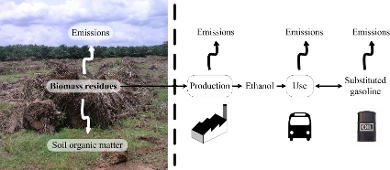Onderzoeksproject
Development of life cycle assessment for residue-based bioenergy
Wat zijn de belangrijkste thema's in het uitvoeren van systemen voor bio-energie ?
- Looptijd
- 2011 - 2015
- Financiering
- This project has has been funded by the Netherland Fellowship Program, grant number 11/92
- Partners
Partner
Short abstract
LCA (life cycle assessment) is an environmental assessment tool for a product system which differentiates the status of an economic flow as goods or waste. Proper identification of an economic status of input and output to a unit process is required as it brings consequences on how LCA should be conducted. In this regard, residue-based bioenergy should be treated differently from product-based bioenergy.

Project description
Residue-based bioenergy has been played a key role in the global energy mix. Exploitation on biomass residues is speculated to increase in the future, driven mainly by the emerging technology on second-generation bioethanol. It is also a consequence of strive competition between food and energy sectors over the same raw materials (sugar, starch and vegetable oil).
Potential bioenergy feedstock from crop residues can reach 3.8 billion tons annually equivalent to a total energy of 70 EJ (Lal, 2005). An optimistic estimate of IEA (2009) suggested that in 2050 bioenergy could sustainably contribute up to a third of global primary energy supply. These resources, however, have to be managed carefully since, in addition to bioenergy, biomass residues have many other competing uses. In particular, those generated in fields play a role in maintaining soil fertility and future harvest. The essential mission is to find out, among various potential uses of biomass residues, which options having the least impact. This thesis focuses on discussing the environmental aspect of residue-based bioenergy.
LCA can shape the future of residue-based bioenergy provided that the assessment is conducted accordingly. It is an environmental assessment tool for a product system which differentiates the status of an economic flow as goods or waste. Proper identification of an economic status of input and output to a unit process is required as it brings consequences on how LCA should be conducted. In this regard, residue-based bioenergy should be treated differently from product-based bioenergy.
The thesis aims at identifying the key problems and at proposing improvements in conducting LCA of residue-based bioenergy. It focuses on four main characteristics associated with the raw materials, biomass residues: excessive removal can affect future biomass productivity, valuation as goods or waste, various competing uses, and treatment as biogenic carbon. These unique features require specific LCA approaches, different from the conventional product-based bioenergy.
The thesis proposed improvement in two key phases of LCA (life cycle inventory, LCI and life cycle impact assessment, LCIA), and methodlogical choices in comparative LCA. More specifically, the thesis proposed:
- Solutions to the existing dissimilar practices on biogenic carbon by treating it as genuine flows (not assuming carbon neutral), but including all relevant flows in the LCI,
- An LCIA method of removing biomass residues from soil on biomass productivity, following the ISO-standard format, comprising a characterization factor and an input term representing changes in elementary flows, and
- Methodological choices in comparative LCA of biomass-residue utilization and demonstrated their implementation on a specific agro-based industrial system (production of crude palm oil).
Although some improvements have been suggested, sustainability of bioenergy cannot be evaluated completely only by utilizing LCA. It needs also complimentary analyses. This is because sustainability of bioenergy systems covers wide variety of parameters, including environment, economic, and social aspects. Under these three pillars, GBEP (2011), for example, set out twenty four sustainability indicators for a bioenergy system.
Bioenergy systems pose more methodological challenges, than other types of renewable energy, since the boundary also includes agricultural phases to produce biomass feedstock. The problem is that agricultural processes lie in the intersection between environmental and economic systems. Meanwhile, LCA methodology has not yet been particularly clear in dealing with direct and indirect land-use changes, and regional variability leading to regionalized impact assessment. These are challenges for further development of LCA to better analyze a bioenergy system.
Wiloso, E. I., and Heijungs, R. (2013). Key Issues in Conducting Life Cycle Assessment of Bio-Based Renewable Energy Sources. In Life Cycle Assessment of Renewable Energy Sources (pp. 13-36). Springer London.
